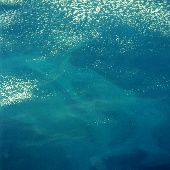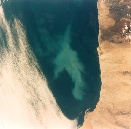Space Shuttle Images of Coccolithophore Blooms
[click on the small pictures on this page to view them at full size]
Shown below are two space shuttle pictures of coccolithophore blooms, the
first is from the North Atlantic and is of Emiliania huxleyi, the
second is off the Namibian coast and may be of another coccolithophore
species. The ethereal, pale blue swirls are as beautiful as a painting.
What causes the bloom to form these delicate wisps, streamers and eddies?
We aren't totally sure, but it is most likely a reflection of the underlying
physical structure of the water. We know that surface ocean circulation
contains many swirls and eddies with this sort of appearance, and the bloom
and non-bloom (paler and darker) portions of the water are most likely
differentiated by changes in temperature and stratification, and thereby
different nutrient concentrations. Ehux may be blooming only in the
more stratified (brighter) water, or perhaps the more nutrient-rich parts of
the water.

Picture from the space shuttle of a coccolithophore bloom in the North
Atlantic. (Photo from NASA).

Picture from the space shuttle of a patch of aquamarine water off the coast of
Namibia. (Photo. from NASA). This was long thought to be a coccolithophore
bloom (and has been labelled as such on this website), but recent work has
shown, surprisingly, that it is more likely to be due to highly relfective
microgranules of sulphur (Weeks et al (2002) Nature, 415:493).
Ehux
home page
Toby Tyrrell : T.Tyrrell@noc.soton.ac.uk

